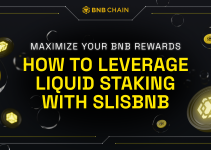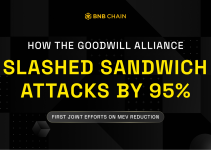Binance has just launched its latest line of futures products, COIN-margined Perpetual Futures.
COIN-margined perpetual futures is the second line of futures products to be margined and priced using a cryptocurrency. This line of Bitcoin-margined perpetual futures will complement Binance’s broad variety of derivatives, including COIN-margined quarterly futures.
But what exactly are COIN-margined Perpetual Futures? In this article, we shall dive into how it works, how it differs from existing futures products, and how it complements them.
What are COIN-margined perpetual contracts?
COIN-margined perpetual contracts are a type of derivative that derives its value from an underlying cryptocurrency. They are an alternative way to gain exposure to a cryptocurrency without having to own it.
With perpetual contracts, you can trade cryptocurrencies with leverage, which means you can magnify small movements in price to potentially generate outsized profits.
Just like USDT-Margined perpetual contracts, COIN-margined perpetual contracts do not have an expiry date. Therefore, users do not need to keep track of various delivery months.
How are COIN-margined perpetual contracts quoted?
Binance’s COIN-margined perpetual contracts are Bitcoin-margined, which means Bitcoin is used as the base currency. Each COIN-margined contract represents 100 USD and as such, USD is the counter currency. Since each contract represents a fixed quantity of USD, this means Bitcoin is used to fund the initial margin or calculate profit and loss.
Let’s take a look at an example:
Assume you purchased 100 Bitcoin-margined perpetual contracts (100 x 100 USD = $10,000) at $12,000 each. By doing this, you are essentially selling USD 10,000 and buying an equivalent value of Bitcoin (10,000/12000 = 0.83 BTC).
Suppose Bitcoin’s price rose to $14,000, and you want to secure profits from the trade. To close the position, you buy back USD 10,000 worth of contracts and simultaneously sell the equivalent of Bitcoin (10,000/14,000 = 0.71 BTC).
In this trade, your profit will be calculated as such: Quantity of Bitcoins at Entry – Quantity of Bitcoins at Close = 0.83 – 0.71 = 0.12 BTC.
Unlike USDT-margined contracts, P&L for COIN-margined contracts is calculated in the respective cryptocurrency (i.e. BTC).
Here are the contract specifications:
| Ticker | BTCUSD Perpetual |
| Contract Type | Perpetual |
| Quote Asset | BTC |
| Tick Size (USD) | 0.1 USD |
| Min. Order Quantity | 1 contract |
| Max. Order Quantity | 100,000 contracts |
| Max. Number of Open Orders | 200 Contracts |
| Contract Multiplier | 100 USD per contract |
| Price Limit | +/- 5% |
| Liquidation Fee | 0.3% |
| Leverage | Up to 125x |
COIN-margined perpetual contracts on Binance offer the following characteristics:
- Priced and settled in BTC: Contracts are denominated and settled in BTC. Hence, it provides ease for new users to participate in these markets.
- No expiration date: Traders can hold positions without an expiry date and do not need to keep track of various delivery months, unlike traditional futures contracts.
- Funding rate: Every eight hours, funding rates are paid either to the long or the short based on differences with the spot right. It prevents lasting divergence in the price of the spot and perpetual contract markets.
Read more about funding rates: A Beginner’s Guide To Funding Rates
More information can be found on our FAQs and guides.
Why trade COIN-margined perpetual contracts on Binance?
COIN-margined perpetual futures offers three major benefits:
1. Shared Margin: Users enjoy synergies between the COIN-margined products (perpetual & quarterlies). Any profits made can be used for margin on either the quarterly or perpetual futures contract; this is particularly useful for those hedging between the two markets.
Let’s run through a quick example. Assume that you are holding a long-term position of 1000 BTCUSD perpetual contracts @ $12,000 each.
You predict a temporary pullback in Bitcoin and want to hedge this risk with a quarterly contract. To hedge, you sold 500 contracts of quarterlies futures.
In this scenario, your prediction came true, and Bitcoin plunged 15%. As a result, your position in BTCUSD perpetual shows an unrealized loss of 1.47 BTC.
However, because you’ve hedged half of your long-term position, profits from the short hedge, which amounts to 0.74 BTC, offset the losses in BTCUSD Perpetual.
Unrealized loss when Bitcoin price dropped 15%:
| Long BTCUSD Perpetual (Sell USD, Buy BTC) | Quantity of Bitcoin at Entry (100,000/12,000 = 8.33 BTC)Quantity of Bitcoin at current price (100,000/10,200 = 9.8 BTC)Unrealized loss = 8.33 – 9.8 = -1.47 BTC |
| Short BTCUSD 0925 Quarterly (Buy USD, Sell BTC) | Quantity of Bitcoin at Entry (50,000/12,000 = 4.16 BTC)Quantity of Bitcoin at current price (50,000/10,200 = 4.9 BTC)Realized profit = -4.16 + 4.9 = 0.74 BTC |
As a result, your margin balance is less impacted despite the sharp pullback in prices, reducing the probability of you facing liquidation.
Additionally, the shared margin feature allows traders to arbitrage between the two markets without the need to maintain multiple accounts or margin. Traders simply need to deposit margin in the BTC-margined wallet, where the same margin balance can be used to open positions in both markets. This means that profits will offset losses in the losing position. Thus, the margin balance only reflects the net P&L between positions in the two markets.
2. HODL & Earn: Binance’s COIN-margined futures is ideal for traders who prefer to hold positions for a long time. Bitcoin investors can now hedge their positions in the futures market without converting any of their holdings into USDT. In other words, they do not need to sell any Bitcoins at a compromised price.
Especially in this bull market today, investors are more inclined to hold on to their cryptocurrency holdings. As contracts are settled in BTC, any profits can contribute to your long-term BTC stack. This is simply a great way to increase your Bitcoin holdings over the long-run. Therefore, traders can use perpetual contracts to hold and potentially accumulate more cryptocurrency (e.g. BTC) for longer-term.
Read more about futures trading strategies: The Ins And Outs Of Futures Spread Trading
3. Customized Margin modes: Thirdly, Binance is the only exchange offering Cross or Isolated margin modes for COIN-margined products.
In a Cross margin mode, your margin balance is shared across all open positions.
In an Isolated margin mode, each open position has an independent margin account.
This means users can enjoy flexible control of their margin balance by either spreading it across all their open positions or setting individual limits for each position they own. Furthermore, Binance also offers users the ability to switch their margin modes at any time.
COIN-margined futures: Perpetual vs Quarterly
Quarterly futures have expiration dates, and trading them means that you own the contract within a given timeframe.
For example, if you go long 1,000 BTC Quarterly 1225 futures contracts for $12,000 and hold those contracts through expiration in December, and the contract settles at $13,500 at expiration, then you will get paid out $1,500 in Bitcoin.
It is important to note that quarterly futures contracts have a tendency to trade at higher or lower prices than the index price. This difference is also known as the futures’ basis. Basis only applies to quarterly contracts because they expire, and users are required to rollover to another contract in a further-out month.
Read more about futures basis: Understanding Price And Basis Of A Futures Contract
In contrast, perpetual futures contracts have no expiration. Instead, these products have a funding period every eight hours, which keeps futures prices close to the index price. Based on the price difference between the index price to its perpetual futures price, traders holding long positions will pay a small fee to traders holding short positions (or vice versa), keeping futures prices close to the index.
In Summary
With the introduction of COIN-margined perpetual futures, users can now enjoy the synergies between the two markets (perpetual and quarterly). Innovative functions such as shared margin and customized margin modes (Cross & Isolated) allow arbitrageurs and sophisticated traders to efficiently manage their margin and P&L. Making it an ideal product for long-term traders, arbitrageurs, and hedgers.
Backed by an industry-leading matching engine and extensive range of hedging tools, Binance Futures is now the preferred hedging venue for traders.


